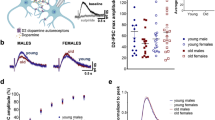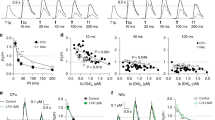Abstract
MANY studies have attempted the elucidation of the homeostatic mechanisms controlling the amount of neurotransmitter released in the synapse. There is convincing evidence that the release of noradrenaline (NA), from both peripheral and central presynaptic nerve endings, can be modulated by a negative feedback mechanism, whereby the neurotransmitter present in excess in the synapse depresses its further release by activating specific presynaptic α-receptors, α-Agonist drugs interact similarly to NA with these receptors and inhibit the depolarisation-induced release of the amine, whereas α-antagonists counteract this inhibitory effect1–10. The appealing concept of a feedback control of neurotransmitter release, although unequivocally demonstrated only for NA, has been generalised to other transmitters. This generalisation seems rather premature. In particular, the existence of presynaptic autoreceptors controlling dopamine (DA) release is often accepted2,7,11,12; however, recent observations13,14 argue against this interpretation and, as pointed out by Langer15, the presence of a direct control of DA release by presynaptic receptors remains an open question. In our studies on DA release described here, our experimental approach differs in two main aspects from those used previously13,14. First, we have monitored the release of 3H-DA synthesised from 3H-tyrosine, in addition to that of exogenous 3H-DA previously taken up by the nerve terminals. Newly synthesised DA is preferentially released by depolarising stimuli16 and may therefore be preferentially influenced by a feedback mechanism. Second, we have used superfused synaptosomes. In our conditions17,18, the DA released is immediately removed from the nerve endings and any autoinhibition of release is minimised. Therefore, presynaptic receptors are completely available to the agonists (which should decrease the depolarisation-induced release) or the antagonists added to the superfusion fluid. Our results show that the DA agonists have no effect on the stimulus-coupled release of DA, either taken up or newly synthesised, from striatal synaptosomes, and therefore militate against a direct control of DA release through presynaptic autoreceptors similar to that demonstrated for NA.
This is a preview of subscription content, access via your institution
Access options
Subscribe to this journal
Receive 51 print issues and online access
$199.00 per year
only $3.90 per issue
Buy this article
- Purchase on Springer Link
- Instant access to full article PDF
Prices may be subject to local taxes which are calculated during checkout
Similar content being viewed by others
References
Farnebo, L. O. & Hamberger, B. Br. J. Pharmac. 43, 97–106 (1971).
Farnebo, L. O. & Hamberger, B. Acta physiol. scand. Suppl. 371, 35–44 (1971).
Enero, M. A., Langer, S. Z., Rothlin, R. P. & Stefano, F. J. E. Br. J. Pharmac. 44, 672–688 (1972).
Starke, K. Naunyn-Schmiedebergs Archs Pharmak. 275, 11–23 (1972).
Langer, S. Z. Biochem. Pharmac. 23, 1793–1800 (1974); Br. J. Pharmac. 60, 481–497 (1977).
Starke, K. & Montel, H. Naunyn-Schmiedebergs Archs Pharmak. 279, 53–60 (1973).
Starke, K. Rev. Physiol. Biochem. Pharmac. 77, 1–124 (1977).
Dismukes, R. K. & Mulder, R. H. Eur. J. Pharmac. 39, 383–388 (1976).
Taube, H. D., Starke, K. & Borowski, E. Naunyn-Schmiedebergs Archs Pharmak. 299, 123–141 (1977).
Dismukes, K., De Boer, A. A. & Mulder, A. H. Naunyn-Schmiedebergs Archs Pharmak. 299, 115–122 (1977).
Westfall, T. C., Besson, M. J., Giorguieff, M. F. & Glowinski, J. Naunyn-Schmiedebergs Archs Pharmak. 292, 279–287 (1976).
Plotsky, P. M., Wightman, R. M., Chey, W. & Adams, R. N. Science 197, 904–906 (1977).
Dismukes, K. & Mulder, A. H. Naunyn-Schmiedebergs Archs Pharmak. 297, 23–29 (1977).
Raiteri, M. et al. in Dopamine (eds Roberts, P. J., Woodruff, G. N. & Iversen, L. L.) (Raven, New York, 1978).
Arbilla, S. & Langer, S. Z. Nature 271, 559–561 (1978).
Besson, M. J., Cheramy, A., Feltz, P. & Glowinski, J. Brain Res. 32, 407–424 (1971).
Raiteri, M., Angelini, F. & Levi, G. Eur. J. Pharmac. 25, 411–414 (1974).
Raiteri, M., del Carmine, R., Bertollini, A. & Levi, G. Eur. J. Pharmac. 41, 133–143 (1977).
Gray, E. G. & Whittaker, V. P. J. Anat. 96, 79–87 (1962).
Hunt, P., Kannengiesser, M. H. & Raynaud, J. P. J. Pharm. Pharmac. 26, 370–371 (1974).
Seeman, P. & Lee, T. Science 188, 1217–1219 (1975).
Iversen, L. L., Rogawski, M. A. & Miller, R. J. molec. Pharmac. 12, 251–262 (1976).
Christiansen, J. & Squires, R. F. J. Pharm. Pharmac. 26, 367–369 (1974).
Smith, J. E., Lane, J. D., Shea, P. A., McBride, W. J. & Aprison, M. H. Analyt. Biochem. 64, 149–169 (1975).
Kehr, W., Carlsson, A., Lindqvist, M., Magnusson, T. & Atack, C. J. Pharm. Pharmac. 24, 744–747 (1972).
Roth, R. H., Walters, J. R. & Aghajanian, G. K. in Frontiers in Catecholamine Research (eds Snyder, S. H. & Costa, E.) 567–574 (Pergamon, New York, 1973).
Grabowska, M. & Andén, N. E. Naunyn-Schmiedebergs Archs Pharmak. 292, 53–58 (1976).
Author information
Authors and Affiliations
Rights and permissions
About this article
Cite this article
RAITERI, M., CERVONI, A., DEL CARMINE, R. et al. Do presynaptic auto-receptors control dopamine release?. Nature 274, 706–708 (1978). https://doi.org/10.1038/274706a0
Received:
Accepted:
Issue Date:
DOI: https://doi.org/10.1038/274706a0
This article is cited by
-
Cannabinoid receptor‐mediated inhibition of acetylcholine release from hippocampal and cortical synaptosomes
British Journal of Pharmacology (2000)
-
The ontogeny of apomorphine-induced alterations of neostriatal dopamine release: Effects on potassium-evoked release
Neurochemical Research (1994)
-
The effect of the dopamine agonist pergolide on tyrosine hydroxylase activity in rat striatal and limbic miniprisms in vitro: A model for the dopamine autoreceptor?
Naunyn-Schmiedeberg's Archives of Pharmacology (1986)
-
Measurement of release of endogenous GABA and catabolites of [3H]GABA from synaptosomal preparations using ion-exchange chromatography
Neurochemical Research (1982)
-
Multiple dopamine receptors: fact, fiction or confusion?
Pharmaceutisch weekblad (1981)
Comments
By submitting a comment you agree to abide by our Terms and Community Guidelines. If you find something abusive or that does not comply with our terms or guidelines please flag it as inappropriate.



